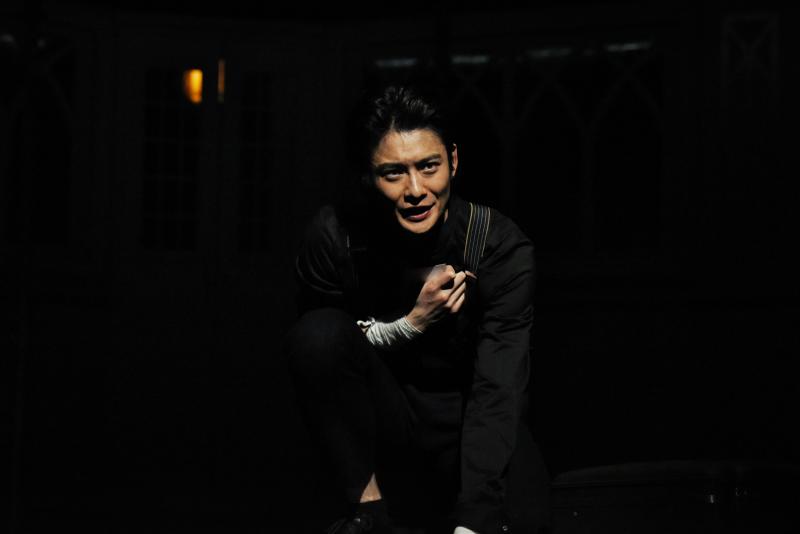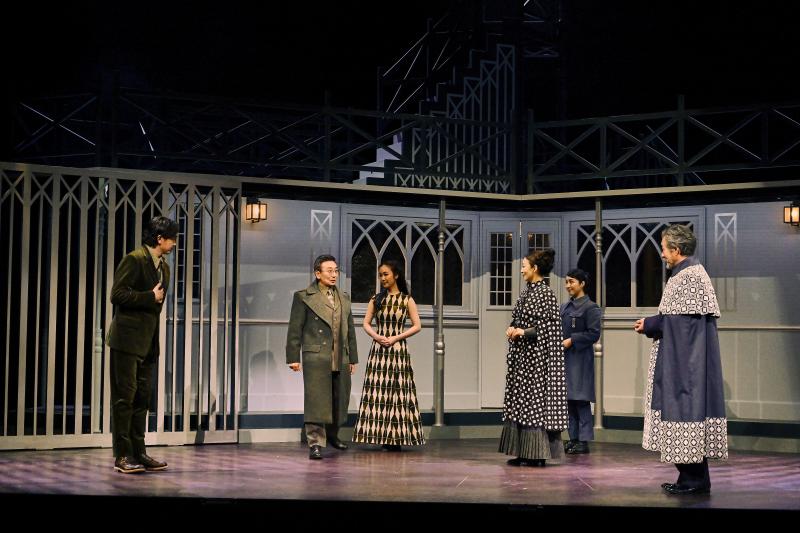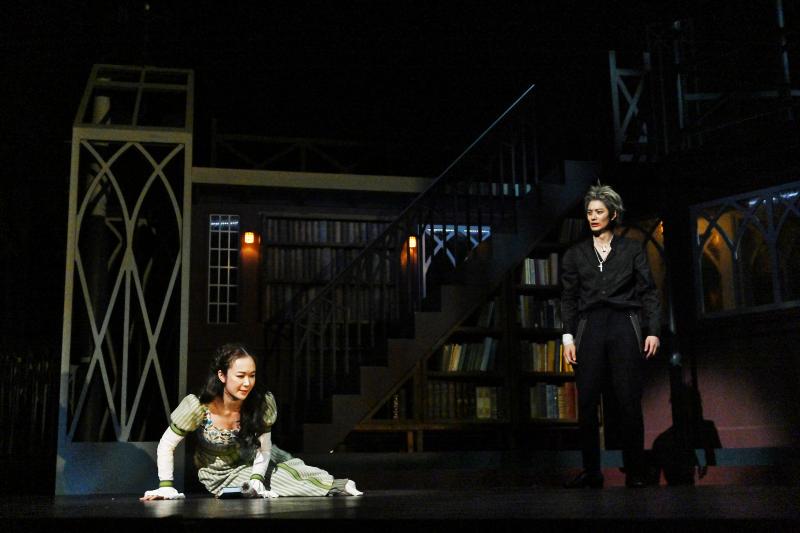BWW Review & Interview: HAMLET speaks in Japanese at Theatre Cocoon
FOR JAPANESE, CLICK HERE!
To be or not to be....in Japanese?

in Tokyo, Japan. 2019. Photo: Shinji Hosono)
Adapting Shakespeare to modern English is task enough, but who would have the guts to translate it into Japanese? Shakespeare Theatre Company's new Artistic Director, Simon Godwin, took on the project as director of a Japanese Hamlet in spring 2019. Audiences in Japan were brought into a new world of theater, with some saying "the first act was fun, and the second act made a major impact."
Shakespeare's works were first introduced to Japan during the Meiji period (1868-1912). His Hamlet has been produced many times over the decades, some productions going as far as weaving Japanese traditional culture into the story.

to Ophelia. Theatre Cocoon, 2019. Photo: Shinji Hosono)
So what made Theatre Cocoon's show different from all the rest? We asked comedic relief Yamazaki Hajime, who played Polonius, his thoughts on being a seasoned Japanese actor doing Shakespeare in his native language.
LARISA: What advice did director Simon Godwin give you that you haven't heard from a Japanese director before?
YAMAZAKI: What was really interesting is that Simon said to us, "First of all, treat this play (HAMLET) as if it were written yesterday." He told me to "Bring the role close to yourself." It was like he was trying to say, "Don't treat this play as an old play: a play is a mirror held up to the present we are living in."
LARISA: How do you study Shakespeare/Old English in Japanese?
YAMAZAKI: Simon Godwin gave us a sort of masterclass on the subject.
LARISA: What advice do you have for actors trying to learn Shakespeare?
YAMAZAKI: Even though it's a classical play, there are no rules we have to follow. Anyone trying to do Shakespeare should start from throwing that kind of prejudice away.
LARISA: How has your character, Polonius, and this show changed to adapt to a Japanese audience?
YAMAZAKI: There are so many changes! Based on Simon's intention to bring the character close to myself, my Polonius is not fat. He is also not so old, and is wearing glasses. In our production, Polonius has a strong relationship with the audience. And that's because I was given the responsibility to make a connection with them, to include them in the show.
The story of Hamlet revolves around the protagonist Hamlet who pretends to go mad after his father, the King's, murder, in order to find out who-dunnit. In the process, half of the cast dies, including Hamlet with the usual, overly drawn-out death scene. But this contemporary version of the story was played in two acts, instead of the infamous three, and was completed in almost 3 hours, including one intermission. "The language was easier to understand," commented one audience member. Another patron, who had never read Shakespeare's Hamlet before, explained after the show how she was "so surprised that so many important characters died!"

Theatre Cocoon, 2019. Photo: Shinji Hosono)
Could William Shakespeare have known that after 400 years his stories would still shock, entertain, and provoke the minds of each new generation? Has he fulfilled every actor, director, and playwright's dream to have their work inspire the world? After all, the point of theater is to tell a story to an audience, in your own interpretation. Luckily, Theater Cocoon in Tokyo is a space which allows just that! Theatre Cocoon has been working with many international creatives, and with them has produced many modern and classical plays. For more details, we will post an exclusive interview with the producer Kato Maki, so check back soon!
The play Hamlet isn't known for its sassy, comedic elements, as a typical musical would be. But Mr. Yamazaki took his interpretation to a relatable level, and had the usually quiet Japanese audience giggling 14 times before intermission. In Japan, it's more respectful to enjoy the show quietly in order not to bother the audience members around you. But, with the introduction of western shows, it's hard not to adapt to the loud culture that comes with them.

LARISA: Your comedic timing was so funny! How much of it is your adlib, and how much is directed?
YAMAZAKI: The script doesn't have any instruction about the timing of jokes, but I wouldn't consider it improvisation because I am doing the same thing every day. But we have different audience every day, and their reactions will always be different. LOL!
YAMAZAKI: Simon trusted me with a lot of it. It was really exciting to work with him! Great sense of humor, and inspiring.LARISA: How is your Polonius different from others who have played this character before?
YAMAZAKI: I didn't think about it beforehand, but several people who saw the show told me they didn't expect Polonius could be this funny. LARISA: Do you have any message for foreigners who want to see a show like this, but don't speak Japanese?
YAMAZAKI: If you know the story, you can enjoy the show even without understanding the language.

Theatre Cocoon, 2019. Photo: Shinji Hosono)
Simon Godwin's Hamlet was led by pop celebrity Okada Masaki as the lead, opposite another famous actor, Aoyagi Sho, as Hamlet's rival, Laertes. The two celebs, along with the rest of their cast, commanded the stage from among the audience. The theater is designed in an old playhouse style, with short-range, rising orchestra seating, rows on the sides, and 2 tiers of balconies. The set design on stage was cleverly crafted on a rotating floor, with a trap door used as Ophelia's grave. How fun for a director and cast to play with!
It's a more intimate experience when the cozy theater space lets you sit inside the story and almost be involved. There is a history of small settings in Japanese theater, but how has the industry changed over the years?
LARISA: How have you seen theater change in Japan during your career?
YAMAZAKI: In my earlier years, the idea of deconstructing a story dominated theater. I started acting at a time when the underground theater movement, known as "Angura" in Japan, was popular. And now sticking to the story has become important and is valued again.
LARISA: What has been your favorite role to play in your career? Why?
YAMAZAKI: I played a father, Takezo, in the masterpiece "The Face of Jizo," written by Japanese playwright Hisashi Inoue. This is a story about a father and daughter who became separated by death from the atomic bomb in Hiroshima. The father who died appears in front of his daughter by chance. The play follows their relationship as the father tries to heal his daughter's broken heart. The conversation of the play highlights the fears of war and the atomic bomb.
HAMLET played at Theatre Cocoon May 9th to June 2nd, 2019.
Tickets could be purchased on the Official Website. (Japanese only.)
To read this interview in Japanese, please CLICK HERE.
*Photo credit belongs to Shinji Hosono. All images used in this article are official promotional images provided by Bunkamura Theatre Cocoon. The text of this article has been pre-approved by Bunkamura Theatre Cocoon.
Add Your Comment
Videos
